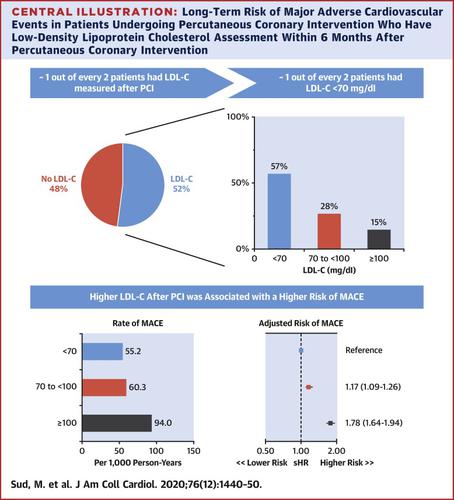当前位置:
X-MOL 学术
›
J. Am. Coll. Cardiol.
›
论文详情
Our official English website, www.x-mol.net, welcomes your feedback! (Note: you will need to create a separate account there.)
Low-Density Lipoprotein Cholesterol and Adverse Cardiovascular Events After Percutaneous Coronary Intervention
Journal of the American College of Cardiology ( IF 24.0 ) Pub Date : 2020-09-01 , DOI: 10.1016/j.jacc.2020.07.033 Maneesh Sud 1 , Lu Han 2 , Maria Koh 2 , Husam Abdel-Qadir 3 , Peter C Austin 4 , Michael E Farkouh 5 , Lucas C Godoy 6 , Patrick R Lawler 5 , Jacob A Udell 3 , Harindra C Wijeysundera 1 , Dennis T Ko 1
Journal of the American College of Cardiology ( IF 24.0 ) Pub Date : 2020-09-01 , DOI: 10.1016/j.jacc.2020.07.033 Maneesh Sud 1 , Lu Han 2 , Maria Koh 2 , Husam Abdel-Qadir 3 , Peter C Austin 4 , Michael E Farkouh 5 , Lucas C Godoy 6 , Patrick R Lawler 5 , Jacob A Udell 3 , Harindra C Wijeysundera 1 , Dennis T Ko 1
Affiliation

|
BACKGROUND
After percutaneous coronary interventions (PCIs), patients remain at high risk of developing late cardiovascular events. Although controlling low-density lipoprotein cholesterol (LDL-C) may improve outcomes after PCI, practice guidelines do not have specific recommendations on LDL-C management for this subgroup. OBJECTIVES
The purpose of this study was to evaluate LDL-C testing and levels after PCIs, and to assess the association between LDL-C and longer-term cardiovascular events after PCIs. METHODS
All patients who received their first PCI from October 1, 2011, to September 30, 2014, in Ontario, Canada, were considered for inclusion. Patients who had LDL-C measurement within 6 months after PCI were categorized as: <70 mg/dl, 70 to <100 mg/dl, and ≥100 mg/dl. The primary composite outcome was cardiovascular death, myocardial infarction, coronary revascularization, and stroke through December 31, 2016. RESULTS
Among 47,884 included patients, 52% had LDL-C measured within 6 months of PCI and 57% had LDL-C <70 mg/dl. After a median 3.2 years, the rates of cardiovascular events were 55.2/1,000 person-years for the LDL-C <70 mg/dl group, 60.3/1,000 person-years for 70 to <100 mg/dl, and 94.0/1,000 person-years for ≥100 mg/dl. The adjusted subdistribution hazard ratios for cardiovascular events were 1.17 (95% confidence interval: 1.09 to 1.26) for LDL-C of 70 to <100 mg/dl, and 1.78 (95% confidence interval: 1.64 to 1.94) for LDL-C ≥100 mg/dl when compared with LDL-C <70 mg/dl. CONCLUSIONS
One in 2 patients had LDL-C measured within 6 months after PCI, and only 57% had LDL-C <70 mg/dl. Higher levels of LDL-C were associated with an increased incidence of late cardiovascular events. Improved cholesterol management after PCI should be considered to improve the outcomes of these patients.
中文翻译:

经皮冠状动脉介入治疗后低密度脂蛋白胆固醇与心血管不良事件
背景 经皮冠状动脉介入治疗 (PCI) 后,患者仍处于发生晚期心血管事件的高风险中。尽管控制低密度脂蛋白胆固醇 (LDL-C) 可能会改善 PCI 后的结局,但实践指南没有针对该亚组的 LDL-C 管理提出具体建议。目的 本研究的目的是评估 PCI 后的 LDL-C 检测和水平,并评估 LDL-C 与 PCI 后长期心血管事件之间的关联。方法 考虑纳入 2011 年 10 月 1 日至 2014 年 9 月 30 日在加拿大安大略省接受首次 PCI 的所有患者。PCI 后 6 个月内进行 LDL-C 测量的患者分为:<70 mg/dl、70 至 <100 mg/dl 和≥100 mg/dl。主要复合结局是心血管死亡,截至 2016 年 12 月 31 日的心肌梗死、冠状动脉血运重建和中风。 结果 在纳入的 47,884 名患者中,52% 的患者在 PCI 后 6 个月内测量了 LDL-C,57% 的患者 LDL-C <70 mg/dl。中位 3.2 年后,LDL-C <70 mg/dl 组的心血管事件发生率为 55.2/1,000 人年,70 至 <100 mg/dl 组为 60.3/1,000 人年,以及 94.0/1,000 人年-年≥100 mg/dl。对于 70 至 <100 mg/dl 的 LDL-C,心血管事件的调整后亚分布风险比为 1.17(95% 置信区间:1.09 至 1.26),对于 LDL-C ≥ 1.78(95% 置信区间:1.64 至 1.94) 100 mg/dl 与 LDL-C <70 mg/dl 相比。结论二分之一的患者在 PCI 后 6 个月内测量了 LDL-C,只有 57% 的患者 LDL-C <70 mg/dl。较高水平的 LDL-C 与晚期心血管事件的发生率增加有关。应考虑改善 PCI 后的胆固醇管理以改善这些患者的预后。
更新日期:2020-09-01
中文翻译:

经皮冠状动脉介入治疗后低密度脂蛋白胆固醇与心血管不良事件
背景 经皮冠状动脉介入治疗 (PCI) 后,患者仍处于发生晚期心血管事件的高风险中。尽管控制低密度脂蛋白胆固醇 (LDL-C) 可能会改善 PCI 后的结局,但实践指南没有针对该亚组的 LDL-C 管理提出具体建议。目的 本研究的目的是评估 PCI 后的 LDL-C 检测和水平,并评估 LDL-C 与 PCI 后长期心血管事件之间的关联。方法 考虑纳入 2011 年 10 月 1 日至 2014 年 9 月 30 日在加拿大安大略省接受首次 PCI 的所有患者。PCI 后 6 个月内进行 LDL-C 测量的患者分为:<70 mg/dl、70 至 <100 mg/dl 和≥100 mg/dl。主要复合结局是心血管死亡,截至 2016 年 12 月 31 日的心肌梗死、冠状动脉血运重建和中风。 结果 在纳入的 47,884 名患者中,52% 的患者在 PCI 后 6 个月内测量了 LDL-C,57% 的患者 LDL-C <70 mg/dl。中位 3.2 年后,LDL-C <70 mg/dl 组的心血管事件发生率为 55.2/1,000 人年,70 至 <100 mg/dl 组为 60.3/1,000 人年,以及 94.0/1,000 人年-年≥100 mg/dl。对于 70 至 <100 mg/dl 的 LDL-C,心血管事件的调整后亚分布风险比为 1.17(95% 置信区间:1.09 至 1.26),对于 LDL-C ≥ 1.78(95% 置信区间:1.64 至 1.94) 100 mg/dl 与 LDL-C <70 mg/dl 相比。结论二分之一的患者在 PCI 后 6 个月内测量了 LDL-C,只有 57% 的患者 LDL-C <70 mg/dl。较高水平的 LDL-C 与晚期心血管事件的发生率增加有关。应考虑改善 PCI 后的胆固醇管理以改善这些患者的预后。



























 京公网安备 11010802027423号
京公网安备 11010802027423号